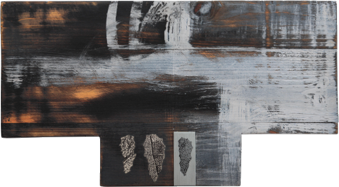These paintings are made with black acrylic paint on canvas or on a wooden board, usually on a gray, white or raw wood background. There may be two backgrounds.
The technique is mixed, using various types of collages, such as frottage, collagraphs, printing, printed patterns, e.g. the work depicting Jacob's fight with the angel, as well as a raster print on canvas or on wood. Sometimes the matrix is glued to the canvas or the frame.
The layouts are mostly T-shaped compositions, especially for works made on wood. There are also diptychs with two connected works, one of which - a narrow rectangle placed under the main pannel – shows a "gallery" of images of paleolithic cut flints.
As he did with his very early works, T.Struk gives titles to three of these paintings :
− The Awakening of Jacob (I-VII)
− The Birth of Sarah
− Presence
Gesture painting consists here of traces of paint crossing the surface of the canvas horizontally and vertically, encountering objects emerging from the ground or the painted background. The effect of thickness is obtained by applying layers of paint. Graphic elements are made in the shape of paleolithic flints.
If the wood has not been completely covered, paint lines create a timeless landscape; the wood, due to its structure, resembles the surface of water.
The traces of the contemporary artist meet those left by a man of the past. This gives the art a sense of being everlasting.
It isn’t that the past casts its light on what is present, or that what is present casts its light on what is past; rather, an image is that in which the Then and the Now come together into a constellation like a flash of lightening.
Walter Benjamin

Different motivations behind this period of creation:
— Periods of life spent abroad (travels to Norway, Finland, Sweden and France-Brittany) and personal events (the death of his father, the birth of his daughter).
— A new direction in artistic activity: the transition from printing to painting. Indeed, printing technique is still visible in the estampage and in elements engraved in the "image".
— Numerous references to places related to megalithic art: The Grave Mound on the island of Gavrinis (3800 BC - 3500 BC)
— Prehistoric areas of Morbihan.
Summer 1986: In the red notebook are the first notes on neolithic excavations visited (Gavrinis, Mane Kerioned) and mentions of the term for stones with carved patterns: petroglyphs.
Of great importance is the ritual of frottage made with ink that allows for transferring patterns carved in stone onto paper.
This is what art shares with religions, the presence of the dead.
André Malraux
In the most accomplished works of this period, we see, on a surface painted in light grey or white, on one hand black lines, sometimes entangled, and on the other hand alignments of engraved elements emerging from a contour of whiteness, as if they came from long forgotten times. In other cases, the image of a neolithic flint is engraved on a plate of zinc which is posed in the painting. The pictorial adventure of the artist integrates and recasts the technique of engraving into a dynamic creation, as the image of time is recorded both in the feverish traces of the artist's gesture and in the permanence of the tools of our ancestors, of which we are reminded.
Tomasz Struk himself emphasized that the patterns on the printed matrices and on the surfaces of the paintings were taken from estampages of petroglyphs he made in Sweden and in Brittany. This voluntary, theatrical act had for him a magical function: it was a ritual restoring the gesture of the man of the past. It was equally an affirmation which consisted of treating the vestiges of prehistory as an inseparable part of the present, without which the image of art created today would be incomplete. The strong implications of the past have to do with a perception of history as destiny.